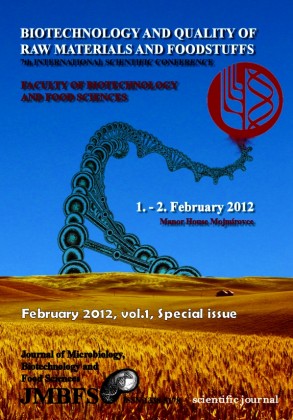CAMPYLOBACTERIOSIS: IMPORTANCE OF STRENGTHENING SURVEILLANCE AND REPORTED FOODBORNE DISEASE CONTROL WITHIN EUROPEAN UNION
Keywords:
campylobacteriosis, changes in epidemiology, Slovak Republic, European Union, statistical analysisAbstract
The aim of the work was to analyze the changes in the epidemiology of campylobacteriosis diseases in Slovakia over the past 10 years and evaluate them in the context of epidemiological changes comparing to the EU. Campylobacteriosis (A045) belong to the diseases with the highest morbidity in Slovakia. Campylobacteriosis remained by far the most frequently reported zoonotic disease in humans in Slovakia as well as in EU. For the period of 2001-2010 was reported in Slovakia25 574 campylobacteriosis cases. Most diseases were reported in 2010 with the number 4591 (84.63 morbidity/100 000 inhabitants). Increase in morbidity is evident since 2003 with an average annual increase of 22%. We focused on more in-depth epidemiological analysis of campylobacteriosis cases in Slovak republic in relation to the infection agens and the outbreak of disease transmission mechanism, age and gender, location and seasonality of disease.Downloads
Download data is not yet available.
Downloads
Published
2012-02-01
How to Cite
Zeleňáková, L., Žiarovská, J., Kozelová, D., Mura, L., LopaÅ¡ovský, ĽubomÃÂr, Bobková, A., Zajác, P., ÄŒapla, J., & Tináková, K. (2012). CAMPYLOBACTERIOSIS: IMPORTANCE OF STRENGTHENING SURVEILLANCE AND REPORTED FOODBORNE DISEASE CONTROL WITHIN EUROPEAN UNION. Journal of Microbiology, Biotechnology and Food Sciences, 1(Special issue), 855–867. Retrieved from https://office2.jmbfs.org/index.php/JMBFS/article/view/7430
Issue
Section
Microbiology
License
Copyright (c) 2012 Lucia Zeleňáková, Jana Žiarovská, Dagmar Kozelová, Ladislav Mura, ĽubomÃÂr LopaÅ¡ovský, Alica Bobková, Peter Zajác, Jozef ÄŒapla, KatarÃÂna Tináková

This work is licensed under a Creative Commons Attribution 4.0 International License.
All papers published in the Journal of Microbiology, Biotechnology and Food Sciences are published under a CC-BY licence (CC-BY 4.0). Published materials can be shared (copy and redistribute the material in any medium or format) and adapted (remix, transform, and build upon the material for any purpose, even commercially) with specifying the author(s).

